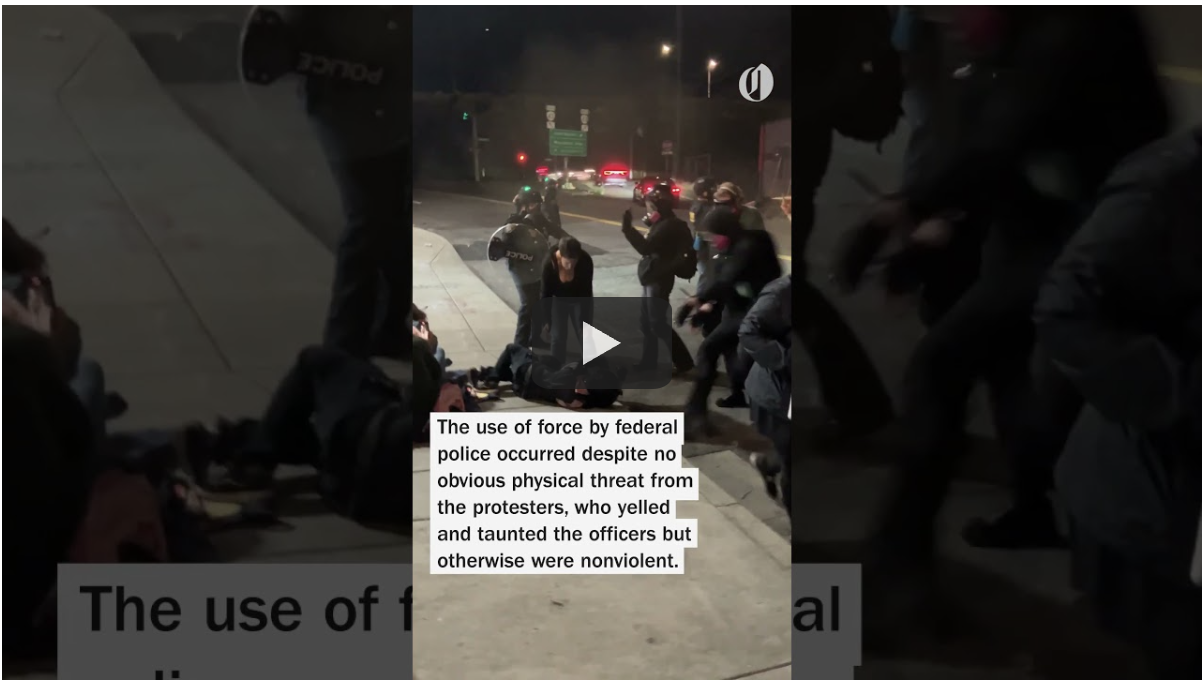PORTLAND, Ore. — Federal agents stationed outside Portland’s U.S. Immigration and Customs Enforcement (ICE) building in South Portland were recorded shoving, hitting, and spraying chemical irritants on demonstrators this week, even though protesters appeared nonviolent.
The confrontations, documented by The Oregonian/OregonLive, add to mounting concerns about excessive force by federal police, echoing complaints and lawsuits from other parts of the country.
Federal Tactics Under Scrutiny
Since early June, protests have regularly taken place outside the ICE facility on South Macadam Avenue. Most of the activity has been confined to a single block, with demonstrators chanting, holding signs, and taunting officers.
Also Read
While tensions have occasionally spiked when police attempted to clear driveways for cars entering or exiting the facility, reporters observed several recent incidents where federal agents escalated confrontations despite compliance from protesters.
On two separate nights, officers advanced on demonstrators, using chemical spray and physical force, leaving some people bruised or burned. Two individuals were detained but later released without charges.
The Department of Homeland Security did not respond to requests for comment.
Resemblance to Barred Tactics in California
The Portland clashes mirror allegations in California, where federal officers faced civil lawsuits for targeting peaceful protesters and journalists. In July, U.S. District Judge Hernán D. Vera prohibited such tactics, writing that under the pretext of protecting the public, federal police had “endangered large numbers of peaceful protestors, legal observers and journalists.”
Vera extended those restrictions earlier this month, fueling debate about whether similar limits should apply in Portland.
Escalation on September 9
On the night of Sept. 9, officers fired crowd-control munitions into the protest area. One demonstrator said he was hit in the groin by what appeared to be a rubber bullet — the third time since he began attending protests. He now wears protective gear, fearing officers are deliberately targeting vulnerable parts of the body.
Witnesses say protesters were not attempting to breach the facility or obstruct vehicles at the time.
Confrontation with Milo Black
One of the most widely shared videos features Milo Black, 35, at the front of a group of about a dozen protesters shortly after midnight on Wednesday. A federal officer with a clear shield pushed Black backward while the crowd shouted insults.
Black extended his arms outward and repeated “back up,” when the officer struck him multiple times in the face and upper body. Moments later, another officer sprayed the group with what appeared to be pepper spray, despite vehicles moving in and out of the facility without obstruction.
As demonstrators recoiled, the shield-bearing officer shoved another woman, knocking her to the ground. When a second protester bent down to help, the officer pushed her as well, sending her crashing to the pavement.
“It was unprovoked,” Black told reporters. “I wasn’t even on government property.”
Expert Calls Force “Completely Inappropriate”
The Oregonian/OregonLive asked law enforcement consultant Jeff Wenninger, a retired Los Angeles Police Department lieutenant, to review the video. Wenninger described the footage as “troubling” and said the force appeared unjustified.
“The push against the woman with her back turned was completely inappropriate,” he said. “She was defenseless. She had her back to him. She was no threat, and he pushed her down. I don’t see how you’re going to find any justification for that.”
Wenninger noted that during his own career, he oversaw protests involving more than 100,000 participants. “Managing large demonstrations doesn’t require indiscriminate violence,” he added.
City Officials and Police Response
The Portland Police Bureau declined to evaluate the footage to determine whether federal officers’ actions violated Oregon law, citing the review as “incredibly time-consuming.” The bureau also declined to comment on federal use-of-force tactics.
Meanwhile, protesters have urged city leaders to sever ICE’s local operations altogether. They argue that the federal presence not only escalates tensions but also endangers community members who exercise their right to protest.
Possible Fallout for ICE Facility
Mayor Keith Wilson indicated this week that the city is reviewing ICE’s compliance with its land-use agreement. According to Wilson, the federal agency has violated the terms 25 times, potentially opening the door for Portland to restrict or revoke ICE’s access to the building.
Such a move would mark a significant step in reshaping Portland’s relationship with federal immigration enforcement, though the process is expected to face legal and political challenges.
Looking Ahead
The protests outside Portland’s ICE facility remain small in scale compared to past demonstrations in the city, but they may foreshadow larger confrontations. President Donald Trump has floated the idea of sending National Guard troops to Portland, a move critics fear would deepen divisions and further militarize the city’s streets.
For protesters like Black, the recent clashes underscore their concern that federal officers are targeting peaceful dissent. “They’re trying to intimidate us,” he said. “But we have a right to be here and a right to be heard.”












